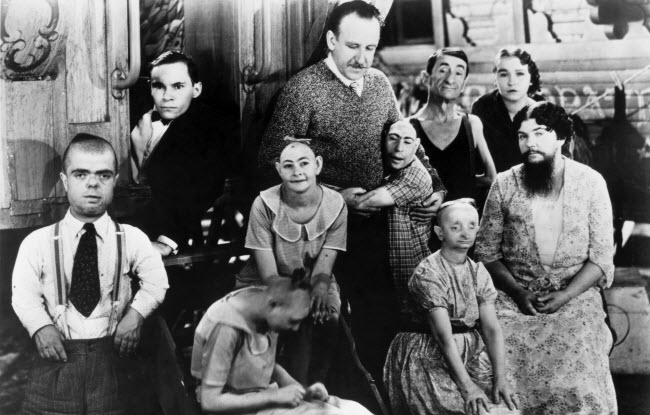In 1931, following the success of the iconic horror film Dracula, American director Tod Browning received the green light from MGM to direct another horror film centered around the theme of revenge within the confines of a traveling circus. Maintaining success can be much more challenging than achieving it, and Browning faced significant hurdles during the filming of Freaks. His previous success became a daunting benchmark, compelling him to incorporate unconventional elements into the film. Upon its release, Freaks shocked audiences with its horrifying and grotesque scenes. Although some consider it a classic today, others regard it as one of the worst films in cinematic history.
The film’s story begins several years before its production, specifically in 1925, when it was merely an idea in development. Browning had previously directed several silent films, including The Unholy Three, which featured a criminal dwarf posing as a baby. The role was played by the diminutive actor Harry Earles. Fueled by success and a desire for more cinematic roles, Earles brought Browning a short story titled “Tottenham,” about two circus performers trying to exploit a wealthy dwarf. Browning was enthusiastic about the story and persuaded MGM to acquire its rights. Despite Browning’s busy schedule directing films for Universal, including the highly successful Dracula, his passion for “Tottenham” remained strong. When he returned to collaborate with MGM, the studio sought to capitalize on Browning’s success in horror by producing a film even more terrifying than Dracula. Thus, Freaks, based on the story, was greenlit.

During the preparation of Freaks, Browning aimed for authenticity. He decided to cast real circus performers with disabilities and deformities, who showcased their conditions in their daily performances, alongside Harry Earles, who would play the role of the wealthy exploiter “Hans.” Browning also successfully persuaded Earles’ sister, the dwarf Daisy, to play Hans’ fiancée “Frieda.” For the rest of the cast, Ben Piazza, responsible for casting, spent a month traveling across the country attending various circus performances and conducting numerous auditions. Notable actors chosen included Johnny Eck, who had half a body, Josephine Joseph, who was half man and half woman, Prince Randian, who had no limbs, and Olga Roderick, known as the “Bearded Lady.” Angelo Rossitto, a dwarf who continued acting for over five decades after the film, and Schlitzie, with his unique head shape, were also cast. Finding ordinary actors was less challenging, but convincing them to accept their roles proved difficult. Actress Myrna Loy was initially cast as the trapeze artist “Cleopatra,” but after reading the script, she felt terrified and begged not to participate, leading to the role being given to Olga Baclanova, a former Moscow Art Theater actress. For the role of the seal trainer “Venus,” Browning wanted Jean Harlow, who was initially announced as one of the film’s stars but was later replaced by Leila Hyams.
While filming Freaks, it became evident that Browning’s insistence on using real circus performers had visually paid off, making the film an unforgettable experience. It added a human touch to the various characters, despite their lack of professional acting experience and the need for special care due to their physical or mental limitations. However, Browning faced significant resistance from many MGM staff members who reportedly felt disgusted by the presence of these actors, with studio owner Louis B. Mayer being particularly shocked. To manage tensions, the studio separated the cast into two groups: the regular actors, including Harry and Daisy Earles and the conjoined twins Violet and Daisy Hilton, were kept in one part of the studio, while the rest of the cast stayed in a tent outside. According to one story, screenwriter Scott Fitzgerald, who was working with MGM, entered the actors’ room, saw the Hilton twins, and was so horrified that he fled to vomit.

Upon completion, Freaks premiered at the Fox Theater in San Diego in January 1932. The initial reception was swift and violent, with one woman screaming and running out of the theater, and another threatening to sue the production company, claiming the film was so horrifying it caused her miscarriage. It remains unclear whether these stories were true or fabricated for publicity. A critic described the film as horrifically shot to cater to the morbid curiosity of those fascinated by deformed humanity. In response to the intense backlash, the filmmakers postponed the release from January 30 to February 20 to make changes, including cutting some violent and frightening scenes, adding more human elements to the deformed characters, and altering the ending to be more positive by reuniting “Frieda” with “Hans.” While these changes were somewhat accepted, the original version, still held by the Fox Theater in San Diego, remains the only place where audiences can view the unaltered film.
Despite its negative reception from audiences and critics at its initial release, Freaks was shown across the country in early 1932 and achieved box office success in some major cities. It faced delays in New York and, when it finally premiered in the summer of 1932, it was a complete failure. The film was pulled from theaters, resulting in a loss of $164,000 against a budget of $316,000 and a significant setback for Tod Browning, whose subsequent film work diminished considerably.
Freaks did not only fail in the American market but was also banned in many other countries, including the UK, for decades. It faded from cinematic memory until its revival at the Cannes Film Festival in 1962. The film found new defenders who argued that people with disabilities should also be allowed to showcase their talents and that they should be encouraged rather than terrorized by negative perceptions.
